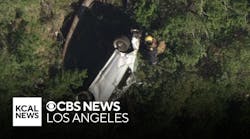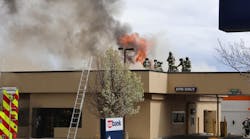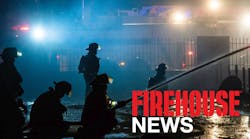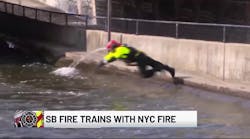Houston, TX, Fire Department Hazardous Materials Response Team personnel from past and present teams gathered on Oct. 16, 2004, to commemorate the first 25 years of service to Houston and South Texas. A dinner was held at the Marriott Houston, where 250 people gathered for the celebration. The “father” of Houston’s hazmat program, Max H. McRae, and former Fire Chief Vernon E. Rogers were recognized for their efforts in getting hazardous materials response started. Representatives of the Houston chemical industry and railroads were also present at the dinner.
Houston is the fourth-largest city in the United States, covering 628 square miles with a population of 4 million. Fire Chief Phil Boriskie leads 3,000-plus uniformed personnel with 85 engine companies, 37 truck companies, 11 booster trucks (for small fires, brush, trash, etc.), 63 medic units, three hazmat units, two technical rescue units, three air cascades, a rehab truck, aircraft fire rescue equipment and miscellaneous vehicles. The fire department is organized into 21 districts with 88 fire stations and five new ones in various stages of construction and development. Houston personnel responded to over 326,000 alarms in 2004, including over 90,000 fires, with an average call volume of over 36,000 per month.
Houston has been referred to as the “Petrochemical Capital of the World.” It is reported that there is a greater concentration of chemical plants and refineries in Houston than anywhere else in the world. Most of the facilities are located along the shipping canal in southeast Houston.
During the 1970s, the idea of organized hazardous materials response by fire departments and other organizations began to develop. Several significant incidents involving railroad tank cars in Crescent City, IL, Waverly, TN, and Kingman, AZ, resulted in changes in response procedures, tank car safety, hazmat transportation markings and regulation at the federal level. The organization of hazardous materials response teams soon followed, with many established by fire departments.
The Houston Fire Department experienced a tank car incident of its own on Mykawa Road resulting from a train derailment on Oct. 19, 1971. Two tank cars of vinyl chloride monomer ignited. There were six cars total of vinyl chloride and one each of acetone, caustic soda, formaldehyde, plasticine and butadiene. The butadiene tank car experienced a BLEVE (boiling liquid, expanding vapor, explosion) resulting in one firefighter fatality and 37 firefighter injuries. Photographs and video of this incident have been circulating through the fire service for years showing a firefighter (Andy Nelson) on an aerial ladder engulfed in flames and smoke following the explosion. That firefighter was burned, but survived.
It was thought that it was the Mykawa incident that motivated Rogers (a district chief at the time of the incident), who was also burned at the incident, to form a hazardous materials team in Houston. However, the team was formed as a result of Rogers attending a fire chiefs’ conference at which a presentation was made by Ron Gore about the new Jacksonville, FL, Hazardous Materials Response Team. Rogers returned home and directed McRae, then a district chief, to organize Houston’s hazmat team.
Starting a hazmat team in the 1970s was difficult because little guidance was available. There were no guidelines for training from the National Fire Protection Association (NFPA) or Occupational Safety and Health Administration (OSHA) at the time and little information about standard operating procedures and proper equipment. Industry was heavily relied upon for expertise, equipment and training. Firefighters were recruited for the team from department ranks, some reluctantly. From the original recruits, only Firefighter William T. Hand has been with the Houston hazmat team since its inception.
Despite a lack of guidance, much of the subject matter for training provided to Houston’s first hazmat team was not that different from today’s lesson plans. Training began with the NFPA’s “Handling Hazardous Materials Transportation Emergencies,” a slide-and-tape program designed for the U.S. Department of Transportation. Visits were made to local chemical facilities, refineries and tank farms for live chemical demonstrations and tours. A class was held on cryogens, along with a show-and-tell with a MC-338 cryogenic tanker truck. Industrial instructors conducted a class covering the use and care of monitoring instruments and “acid suits” (terminology of the time for today’s chemical suits).
Training also was conducted at a chlorine plant covering the characteristics of chlorine, chlorine containers and hands-on training for Chlorine A, B and C Kits. Team members were then exposed to several chemistry class sessions. A field trip took team members to the Richmond Tank Car Co. to learn how tank cars were constructed. Scott Aviation provided training on new positive-pressure self-contained breathing apparatus (SCBA).
Interestingly, some of the recommended procedures at the time are still in use today, such as establishment of the “hot zone” and use of the buddy system and backup teams. Pesticide training was accomplished using the National Fire Academy’s “Pesticide Spills & Fire Control” slide program. Hands-on-training was provided by Dow Chemical Co. representatives on mitigating leaks from drums, tanker trucks and rail cars.
The first hazmat vehicle used by the Houston Hazardous Materials Response Team was an old 1967 International step van rescue truck retrieved from a salvage yard. Designated as HM-1, the unit carried Chlorine A, B and C Kits, a high-expansion foam generator and foam concentrate, SCBA, proximity suits, lifting bags, acid suits and chemical gloves. Monitoring equipment included a combustible gas indicator with an oxygen cell, carbon monoxide monitor and Civil Defense Geiger counters. Following several months of training and equipping of the response vehicle and facing an uncertain future, the team was activated at 6:30 A.M. on Oct. 5, 1979. The cost of training and equipping the new team was approximately $19,000.
The new hazmat team was assigned to Fire Station 1 and would also run rescue calls with a new rescue unit as one of eight rescue teams in the city. On the team’s first day of service, it was called on to mitigate a small chlorine leak. An additional 29 hazmat alarms were answered that first year. More hazmat alarms had occurred during the first year and through the years to come, but the dispatchers did not always remember that the department had a hazmat team and other companies were dispatched instead.
Despite early organization difficulties and growing pains, Houston’s Hazardous Materials Response Team became the busiest and one of the best such teams in the country. It was used as a model for other fire departments starting their own teams during the 1980s and ’90s. Hazmat personnel from around the world have ridden with Houston’s team in its ride-along program; many visitors see more hazmat responses in a week in Houston than they would in months or even years in their own departments.
Houston’s Hazardous Materials Response Team has been a stand-alone unit since 1983 and is dedicated to hazmat response and other hazmat duties. Team quarters moved from Station 1 (now a restaurant) to Station 17, to Engine 22, Ladder 22, and Medic 22 and then relocated 20 miles to its current quarters. Engine 78 is located at the former Engine 22 Station and Engine 22 and Ladder 22 were taken out of service. Hazmat 22 currently operates out of relocated Station 22 at 7825 Harrisburg St. Station 22 is located close to Houston’s petrochemical area and hazmat units have a 20- to 25-minute response time anywhere in the city.
Houston has experienced numerous major hazardous materials incidents, before and since the hazmat team was formed. Anhydrous ammonia has been the source of several incidents. One emergency involved an anhydrous ammonia tanker truck on May 11, 1976. The MC 331 crashed through a guard rail and released ammonia on a freeway below. Many motorists were trapped in their cars by the ammonia vapors; seven died and 150 were injured. Several firefighters were also treated for ammonia inhalation.
Another ammonia incident occurred on Dec. 11, 1983, when the Borden’s Ice Cream Plant experienced an explosion from leaking anhydrous ammonia used for cooling at the plant. There were no deaths or injuries. Several events delayed firefighters from entering the building before the explosion occurred that certainly would have caused firefighter injuries if not death.
One such delay occurred when firefighters outfitted the plant engineer with SCBA and provided impromptu training so he could enter with them and point out a leaking valve. The explosion occurred as they walked toward the building. Hazmat personnel had not yet arrived on scene when the explosion took place, and that may have saved them from injury and death as well.
At the time, there was a great deal of surprise among firefighters that ammonia would burn or explode. Previous procedures were to enter the building with chemical protection and stop the leaks. Following the Borden plant incident, procedures were changed to ventilate the building thoroughly before entering to plug leaks.
One of the largest fires to ever challenge the Houston Fire Department occurred on June 24, 1995. Seven alarms were transmitted for the Houston Distribution Warehouse complex located at 8550 Market St., starting with the first at 8:33 A.M. Two-thirds of the city’s on-duty force was called on to fight the stubborn fire over the next 31 hours. Thirty-one engine companies and 14 ladder companies fought the fire. Warehouses in the complex were loaded with organic and inorganic chemicals, including corrosives, motor oils, plastics, solvents, cleaning compounds, lubricants, organophosphorus pesticides, flame retardants and metallic compounds.
Hazmat units responded on the second alarm. The fire overcame the building’s sprinkler system and firefighter hose streams, and by 11 A.M. the building was totally involved. Exposures included five tractor-trailers loaded with organic peroxides and a liquefied petroleum gas rail car. Lines were placed in service to protect exposures and protective booms were placed to keep runoff water from entering storm drains. Mutual aid was requested from Channel Industries Mutual Aid (CIMA) at 7:30 P.M., which brought 10 foam tankers, four 2,000-gpm monitors mounted on trailers and a 6,700-gallon foam tanker to the scene.
After pouring foam on the fire all night, firefighters brought it under control at around 3 o’clock the following morning. Fire units remained on scene for several days putting out flair ups. Despite the magnitude of the fire and the chemicals involved, only three firefighters sustained minor injuries.
Houston’s hazmat personnel operate as a team with confidence in their abilities and in each other. Captains function like quarterbacks and not coaches. Personnel must take the Houston Tech Course to get on the hazmat team.
Today, Station 22 is home to two identically equipped hazmat response units, which are 1995 and 1996 Super Vac units. Also located at Station 22 is Foam Engine 22, which is a 2000 Emergency One with a 2,000-gpm pump, 500-gallon water tank, 750 gallon foam tank, 1,000 feet of four-inch hose and a Williams Hot Shot II Foam System. Engine 22 also carries decontamination equipment and can respond alone on some types of hazmat alarms. A flatbed utility truck for carrying bulk foam and other equipment is housed in a utility building behind Station 22.
Houston uses Scott 4.5 SCBA with one-hour bottles as the team’s only respiratory protection. Chemical suits are Kapler Responder for Level A and Kapler CPF 2 and 3 for Level B. They have both encapsulated and non-encapsulated Level B suits. Scott in suit communication systems are used for team communication during entries. Station alarms are received through an animated voice dispatch system generated by a computer.
Monitoring equipment carried on the hazmat unit includes four-gas meters, Mini RAEs, Sol Mini-CAD, radiological instruments and APD 2000. Reference materials consist of a laptop computer with CAMEO and Internet access, ERG, NIOSH, Bureau of Explosives Book, Condensed Chemical Dictionary, pesticide manual and various military agent books.
The hazmat station is a dedicated station with 11 hazmat technicians on duty each shift. Approximately 20 additional hazmat technicians are scattered throughout the city, but are not part of an organized response. Houston firefighters work a 46.7-hour work week with 24 hours on, 24 off, 24 on and five days off. The response area for Hazmat 22 includes the City of Houston and Harris County, and it has responded as far away as Austin County, Montgomery County and Galveston.
The hazmat team relies heavily on the Channel Industries Mutual Aid Group (CIMA) for backup during incidents. The team also has mutual aid agreements with the newly formed Harris County Hazmat Team and the Ponderosa Volunteer Fire Department team. Assistance is also received from the Metropolitan Medical Strike Team (MMST) based in Houston.
Hazmat 22 responds to an average of 1,200 alarms per year, not including fuel spills handled by other companies. Engine companies throughout the city carry 10 gallons of hydrocarbon dispersant for use on small fuel spills. Anything larger requires the response of the hazardous materials unit. Houston uses a liquid agent dispersant for hydrocarbon spills. Brush rigs have been outfitted with spray booms that apply the agent to the surface of the spill.
Current training includes rules and regulations, personal protective equipment (PPE), plugging and diking, rail cars, tank trucks, decontamination, foam operations and chemistry. All firefighters in the Houston Fire Department are trained to the hazmat awareness level.
Primary hazmat transportation exposures are Interstates 610, 45, 10 and 59. Major Texas highways include 225. The ship channel from the Gulf of Mexico at Galveston allows for oceangoing vessels to make port in Houston. A Union Pacific rail yard and a local rail line also are within the department’s jurisdiction.
Major fixed facility exposures are located along the shipping channel and include refineries, major oil companies Phillips and Shell tank storage, natural gas wells, ammonia plant, the largest H2SO4 recycle plant in U.S., Houston Alkynes, Liquid Air Products, NASA Johnson Space Center, medical centers and universities, and small companies. Chemical exposures include chlorine, LPG, ammonia, H2SO4, bleach, zinc and combustible metals.
Further information about Houston’s Hazardous Materials Response Team may be obtained by contacting Captain Troy Lilley at 713-928-6711.
Robert Burke, a Firehouse® contributing editor, is the fire marshal for the University of Maryland. He is a Certified Fire Protection Specialist (CFSP), Fire Inspector II, Fire Inspector III, Fire Investigator and Hazardous Materials Specialist, and has served on state and county hazardous materials response teams. Burke is a veteran of 26 years in fire and emergency services, with experience in career and volunteer departments. He has attained the rank of lieutenant, assistant chief and deputy state fire marshal. Burke is an adjunct instructor at the National Fire Academy and the Community College of Baltimore, Catonsville Campus, and the author of the textbooks Hazardous Materials Chemistry for Emergency Responders and Counter-Terrorism for Emergency Responders. He can be reached on the Internet at [email protected].











